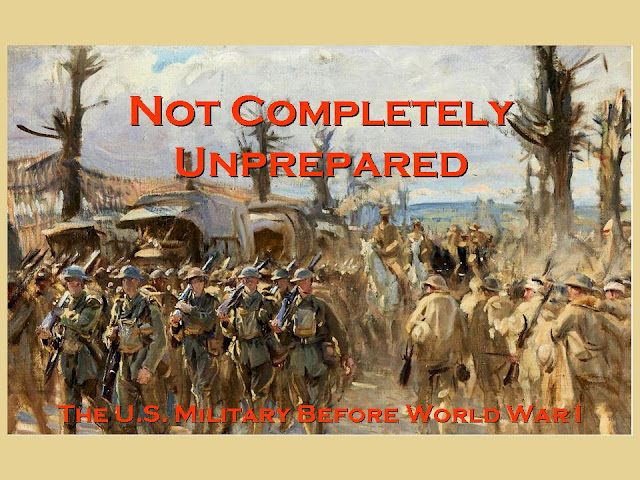"America was completely unprepared for the war." You've probably seen some form of this statement in your readings. The statistics seem to fully support this. On 1 April 1917, the U.S. had 5,791 officers and 121,797 enlisted men in the regulars, supplemented by 80,446 National Guard on Federal service and 101,174 guardsmen still under state control. The Marine Corps had 462 commissioned officers, 49 warrant officers, and 13,214 enlisted men on active duty. The total available manpower of 323,133 certainly seems inadequate for getting involved in a global war in which all the other contenders were fully mobilized by the millions. Also, many of the 300,000+ were already tied up in deployments overseas and on the still active Mexican border. The U.S. Navy seemed readier with 36 new and old battleships, about 100 cruisers and destroyers, and 52 submarines, but in retrospect were lacking sealift capability for moving troops and supplies to Europe. So the statistical case for "completely unprepared" for hostilities seems quite solid.
Yet, the works that dwell the unpreparedness factor seem all to imply that what happened over the next 19 months, when the United States had mobilized 4 million of its citizens and had already deployed half of them to the war's key theater, where they would decisively shift the balance of power on the battlefield, was either accidental or magical. Or—the authors remain silent on the point.
My long-held view is that America was no more "completely unprepared" for this rapid mobilization and deployment than that the achievement was simply sleight-of-hand. In 2017, I was invited to present my views during the Burdick Military History Symposium at San Jose State University. In this article, I'm going to let the slides I prepared for the program make the case for me. All of them can be enlarged by clicking on them. Please share your views in the comments below. MH















Superb reminder. Thanks
ReplyDeleteWell, Mike, I'm sure you're prepared for contrary opinions! On the subject of "sound organisation", my research on observation balloons indicates that the employment of balloons in the Cuban War was an unmitigated shambles from inception to ignominious end! The state of the US ''air force" in 1914 was parlous to say the least, and the supply of equipment throughout the war was patchy. Where I think the US shone was in the speed and effectiveness with which it recruited, clothed and supplied, trained, and dispatched huge numbers of men to the war front. Munitions (broadly defined) seemed to lag.
ReplyDeletePerhaps this is a Great War example of the triumph of American organizational and industrial capabilities that were later exhibited during World War II. The World War II accomplishments are documented in "Arsenal of Democracy" by A. J. Baime and "Freedom's Forge" by Arthur Herman. My reviews of these can be found at: https://warhistorynetwork.com/groups/reader-s-corner-books-of-world-war-ii-history
ReplyDeleteExcellent Power Point!
ReplyDelete